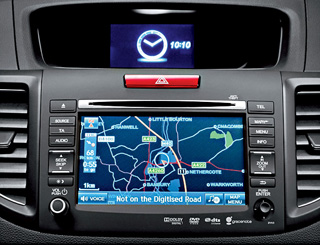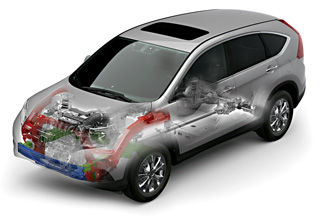Honda CR-V test drive since 2011 crossover
Well Done, sir!
 Whether a joke, but the chief interior designer of the new Honda CR-V claims that a special marbled pattern of Japanese beef influenced the choice of material for decorating the front panel. It is a pity, I have not tried Asian marble meat, otherwise I would definitely compare. In any case, the next generation of the Honda CR-V crossover, which I tested on Munich’s roads, turned out, as the British say, Well Done.
Whether a joke, but the chief interior designer of the new Honda CR-V claims that a special marbled pattern of Japanese beef influenced the choice of material for decorating the front panel. It is a pity, I have not tried Asian marble meat, otherwise I would definitely compare. In any case, the next generation of the Honda CR-V crossover, which I tested on Munich’s roads, turned out, as the British say, Well Done. The Gurman-Interior is the name of Takehiro Ishibashi. His work is more evolutionary than revolutionary. The general architectural composition of the internal space has been preserved: all the same selector of the CP on the central console, the same climate control unit, the same key -familiar keys. But having recovered from Dejavu, you begin to notice that everything has become harder: the feeling that the salon was collected from other people's details disappeared. I especially want to note a long horizontal bar of silver plastic with an elegantly inscribed in it by the button to start the engine the border between the upper and lower zones of the front panel.
You note a qualitative approach in any tactically accessible place, whether it is the main elements with the above meat texture, whether it is rare smooth plastic (even it is made with matte and barely rubberized). Such concern for your feelings bribes. But some solutions are incomprehensible, if not funny. It was not for anyone, and most importantly for the Japanese themselves, it was a secret that people even a central tide of a console in the form of an inverted trapezoid, on which a lever of 6-speed mechanics or a 5-speed machine, unpleasantly propped up his right leg. In the new CR-V, instead of obeying him differently, the pillows (!) Hodingly attached to him on the left and right.
The parking brake handle, made in the manner of traction controls in aviation in its place, is now a familiar lever, has gone the past. From now on, the driver and passenger shares the central section with the armrest and the cup holders, inside which the ducts go to the rear riders.
The front seats are good in shape, but in cheap trim levels instead of the skin, a tenacious velor is used, and this brings its own spoon of tar. The floor of the car is unusually high relative to the seats, which is why you first feel some discomfort both in place of the driver and the passenger of one, one is close to the pedal node, and the other has nowhere to stretch your legs. It's all about the bottom, which is done so that on the back sofa you will not find the tunnel familiar in the full-wheel drive cars for the cardan shaft. Of course, this is an illusion, for the sake of which the other sections of the floor had to be raised.
Appearance? In my opinion, the generation as a whole looked more collected. The new CR-V raises only one angle of three quarters in front, it is a pity that in life we \u200b\u200bare used to looking at cars that way, but the aerodynamic resistance coefficient is reduced by 6.5%. Separate details attract more. By the way, the mirrors inherited from the last model, and the rear lighting technology obviously hints at Volvo XC60 this was noted by everyone. Interestingly, the dimensions of the novelty have decreased: in length it lost 5 mm, in an altitude of 30 mm. In general, this did not affect the sensation of the internal space.
Unfortunately, traditionally they will not bring us a diesel version of the new Honda CR-V, and it is very good. A 2.2-liter motor with heavy fuel with a turbine of variable geometry still develops 150 liters. with. and 350 nm of torque with slightly reduced emissions of CO2. Its combination with a 6-speed mechanical KP vigorously accelerates in any speed range, and elasticity is good not tired of frequent undermining the steps.
 A pleasant roar of diesel is heard only by the red zone of the tachometer. The rest of the time in the cabin is simply fantastic silence, and even on autobahnia 160180 km/h. The Japanese thoroughly worked on sound insulation, thanks to which there were no tires or aerodynamic noise. The bottom and salon are separated by a special absorbing material of a large area, its analogues are installed in the partition of the motor compartment and the baggage compartment doors. The seals of the remaining doors are reinforced, the rear wheeled arches are covered with pile.
A pleasant roar of diesel is heard only by the red zone of the tachometer. The rest of the time in the cabin is simply fantastic silence, and even on autobahnia 160180 km/h. The Japanese thoroughly worked on sound insulation, thanks to which there were no tires or aerodynamic noise. The bottom and salon are separated by a special absorbing material of a large area, its analogues are installed in the partition of the motor compartment and the baggage compartment doors. The seals of the remaining doors are reinforced, the rear wheeled arches are covered with pile. Until the New Year, only gasoline machines with a 2-liter engine familiar in the old generation will be brought to Russia, and dealers have already begun to receive orders. In the European specification, a power unit with a branded system of step valves of VTEC valves added 5 horses in power, however, in connection with the transport tax rates, CR-V, still developing 150, and not 155 liters, will most likely come to us. with. Although we note that the difference in deductions to the treasury is small, for example, 1390 rubles. For Moscow.
The two-liter CR-V is not so silent. Indeed, in order to tell the car at least more or less tangible acceleration, the motor has to twist to the top. Only there something is happening, but accompanied by an unpleasant howl of the engine. Perhaps the whole thing is in an obsolete 5-speed automatic transmission, which, according to the tradition of Honda, is a high box (usually use planetary rows) with a hydrotransformer and individual friction couplings in each of the programs. By the way, these automatic transmission is praised for comparative simplicity and reliability. Maybe with the advent of a new 6- or 7-speed machine CR-V 2.0 will go in a new way, but the Japanese do not name the deadlines.
The brakes of both versions do not cause complaints, since both the effort on the pedals and its course have the usual values. The suspension scheme has not changed: mcpherson in front, design of two levers from behind. The course of the diesel machine is not bad, neither the joints nor the irregularities of different sizes are annoyed. In more than 100 kg of gasoline version of the case, the flaws are a little worse, and the flaws are more noticeable. In addition, in both cases, the body is unnecessarily fired in the snails of the interchanges, it would be nice to strengthen the stabilizers of the pure stability.
The main change in the chassis is a new electromechanical steering amplifier. Its engine is installed directly on the rail, and concentrically with the last and without using belt transmission, the same compact solution is used on the new Audi Q5. Unlike a German, in the Japanese, the artificiality of the emergence of a stabilizing moment is more noticeable, but in general, the mechanism is good. There are only complaints to the work of the strip control system: active resistance when changing a row without turning on the turn signal is so blurry and slurred that it seems that the connection with the wheels is lost. But the machine itself turns in gentle bends, clinging to continuous marking on the roadsides, but this happens only within a few seconds, after which the driver’s intervention is required.
For the first time, the front-wheel drive version of Honda CR-V enters the market, but it will probably not be supplied to us either. CR-V with all the leading wheels finally waited for the replacement of an obsolete clutch of inclusion of all-wheel drive to a new one. Due to the lack of electronics, the old mechanism worked with delay and with minor changes was installed on CR-V since its debut in 1995, that is, almost two decades ago. Now, thanks to the new coupling, the rear gearbox has become easier for 16 kg and improved the efficiency.
The principle of its operation is similar to the Haldex coupling, which is installed, for example, on Volkswagen Tiguan: the inclusion of an electric oil pump at the command of the control unit provides compression of the friction discs due to pressure on the piston. This means that now, even before slipping the anterior axis, the electronics can provide pre-blocking the coupling of the coupling if CR-V starts uphill (a separate button that provides a rigid connection of the rear axle, no).
According to the Russian representative office of Honda, cars with engines of 2.4 liters (there were no presentation) will appear in the salons only next year. Now Honda CR-V is seriously losing in sales (9712 pcs. In 2011) its main competitors Toyota RAV4 (27 206) and Nissan X-Trail (22 689). Of course, the reason lies in the low selection of configurations and quite high prices. But the good beef is not cheap today, right?




Source: Cars














